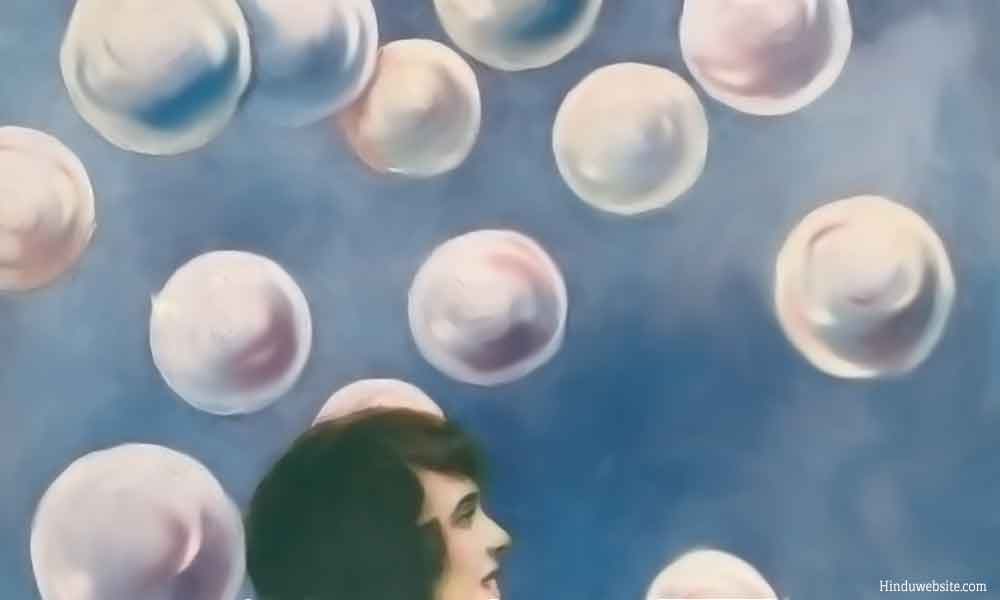
Symbolism of Bubble in Hinduism

The archetypal meaning, cultural significance and symbolism of bubble (budbuda, jalabuda, or phenapinda) in Hinduism
A bubble (budbuda, phenapinda, bhindu, or phenagra) is a temporary formation and contains within itself air (prana). From this perspective the body of a living being is comparable to an air bubble since it holds air (prana) within itself. Like the air bubbles each being is swayed by the winds of fate or karma in the mortal world. Just like the human beings, each bubble has a brief existence at the end of which it simply vanishes without leaving any trace. In the waters of life beings rise to the surface as bubbles and disappear after their brief existence.
Life not only ends like a bubble but also begins as a bubble. A verse from the Bhagavatham (3.31.2) states that life arises from a bubble in the womb when the sperm and ovum combine and ferment into a bubble. Creation is often described in the Hindu literature as the froth that floats upon the waters of existence and disappears when its time is due.
The fragile nature of bubble denotes the impermanence of the mortal world. Over exuberance of anything, such as wealth, happiness or good fortune, is also compared to a bubble because of its impermanence. Emotions and feelings well up in the waters of consciousness like bubbles.
A bubble also gives the illusion of form and color, just as the body. As it floats in space pushed by the winds, one is reminded of the embodied souls that are caught in the cycle of births and deaths and pushed around by the winds of fate.
A dream is also like a bubble, which freely floats in the space of the mind and disappears when one wakes up or falls into deep sleep. Like the bubble, each mortal appears in the mortal world for a short time, radiating the light of life and disappears into the mysterious nothingness.
Thus symbolically a bubble denotes many things, life, creation, the body, soul, illusion, form, impermanence, freedom, vulnerability, subtle world, and a dream.
Suggestions for Further Reading
- The Symbolism of Lord Ganesha
- Symbolism of Goddess Lakshmi
- The Symbolism of Mahishasura Mardini
- Symbolism of Sri Satyanarayana Puja
- Human Body Symbolism in Hinduism
- Symbolism in the Story of Sagar Manthan, the Churning of The Ocean
- Symbolism and Significance of the Descent Of Ganga
- Symbolism of Ganga As the Purifier and Liberator
- Symbolic Significance of Hanuman or Anjaneya
- Symbolic Significance of Numbers in Hinduism
- Symbolism of the Main Characters in the Bhagavadgita
- he Meaning And Significance of Prarthana or Prayer in Hinduism
- Mantra, Tantra and Yantra in Hinduism
- The Symbolic Significance of Puja Or Worship In Hinduism
- Symbolism in Hinduism - Links
- Symbolic Significance of The Hindu Trinity, Brahma, Vishnu And Siva
- Should We Call Hinduism Santana Dharma?
- The Symbolism of Snakes and Serpents in Hinduism
- Significance of Death in Hinduism
- Significance of Happiness in Hinduism
- The Body as an Abode of Gods
- The Symbolism of Time or Kala and Death in Hinduism
- Lessons from the Dance of Kali, the Mother Nature
- Maslow's Hierarchy Of Needs And Purusharthas of Hinduism
- The Meaning and Significance of Heart in Hinduism
- The True Meaning of Prakriti in Hinduism
- Essays On Dharma
- Esoteric Mystic Hinduism
- Introduction to Hinduism
- Hindu Way of Life
- Essays On Karma
- Hindu Rites and Rituals
- The Origin of The Sanskrit Language
- Symbolism in Hinduism
- Essays on The Upanishads
- Concepts of Hinduism
- Essays on Atman
- Hindu Festivals
- Spiritual Practice
- Right Living
- Yoga of Sorrow
- Happiness
- Mental Health
- Concepts of Buddhism
- General Essays